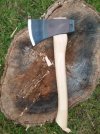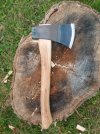Some quick notes about the Flying Fox. First, it came fast and well packed as I'm accustomed to when buying from Baryonyx Knife Co. Kudos there.
Now on to the hatchet. It's very well made. The "sport utility finish" suits me fine. An axe should be first and foremost a utility tool. The bit, poll, top and bottom are accurately ground. The rest appears to be a sand cast finish. It came with a relatively sharp edge but with a noticeable burr on one side of the bit. I spent 60 seconds with an Arctic Fox round stone to clean it up. I took off the burr with the coarse side and then honed each side quickly with the fine side. This produced a good working edge but not quite shaving sharp.
The bit is perfectly aligned to haft.
It's easier to control this alignment in cast steel than in forged steel. And cast steel can be just as good as forged steel it the heat treat is done right. I haven't file tested this yet but I will and I'll report back when I do.
The hang is extremely good with the eye filled tightly top and bottom. If it wasn't for the round wedge I'd be proud if all my hangs looked like this. I'm impressed.
The grain alignment in the handle is good. Not exactly perfect but nearly vertical and good enough that it gives me no concern whatsoever on this size/weight of tool. The handle wood is solid and rings like a piece of flawless hardwood should.
I took it out back and did some chopping on a piece of fully seasoned black locust - a good solid hardwood. The bit experienced no chip or roll. Nor did it stick in the wood as many thin-bitted hatchets would.
Next I tried it on a semi-dry softwood, a piece of arborvitae. It didn't stick while chopping this softwood either, which is what I was testing.
Council has made a very good compromise in the geometry of this hatchet. Marketed as a throwing axe it has to be thin-bitted to stick reliably in the target. Still they've given it enough of a high centerline that it isn't sticky as a chopper. It's a fine balance but I think they've struck it well.
If I were going to use it as a thrower I would resharpen the bit with a very slightly concave bevel to give it the maximum stick. As a camp utility chopper I will file the bevel back just a little further in the center and I will blend it in along the the entire bit. It will chop better after this.
Overall I'm very pleased and impressed with the tool. They got a lot of things right to a very high degree. For my uses as a camp utility hatchet I think it will benefit from being re-fitted on an 18" straight haft with a little more pronounced swell. In fact the only think I would mark this hatchet down on is the transition from grip to swell. It's not as pronounced as I would like. But this transition is appropriate for a thrower. Again a good compromise.













